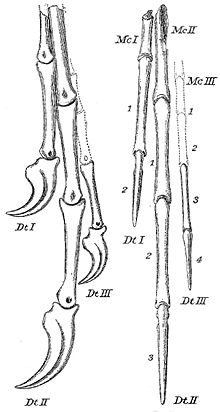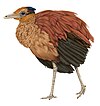纖手龍屬
| 纖手龍屬 化石時期:上白堊紀
| |
|---|---|

| |
| 正模標本的手部 | |
| 科學分類 | |
| 界: | 動物界 Animalia |
| 門: | 脊索動物門 Chordata |
| 綱: | 蜥形綱 Sauropsida |
| 總目: | 恐龍總目 Dinosauria |
| 目: | 蜥臀目 Saurischia |
| 亞目: | 獸腳亞目 Theropoda |
| 科: | †近頜龍科 Caenagnathidae |
| 亞科: | †單足龍亞科 Elmisaurinae |
| 屬: | †纖手龍屬 Chirostenotes Gilmore,1924 |
| 模式種 | |
| 纖瘦縴手龍 Chirostenotes pergracilis Gilmore,1924
| |
| 異名 | |
| |
纖手龍屬(學名:Chirostenotes,意為「狹窄的手」)是生活在7650萬年前,白堊紀晚期加拿大艾伯塔的偷蛋龍類。其模式種為纖瘦縴手龍(C.pergracilis)。
描述[編輯]
縴手龍有着末端纖細的長手臂、長爪子和具有纖細腳趾的長腿,約2米(6.6英尺)長。縴手龍有可能是雜食動物或食草動物,這是根據其近親安祖龍屬和近頜龍屬的喙所推斷。
2005年,Phil Senter和J. Michael Parrish公佈了關於縴手龍手部的用途以及其細長的第二根手指與直爪可能用作縫隙探測適應的證據的研究。他們提出縴手龍可能以第二根爪刺穿軟體動物為食,如蠐螬、無裝甲的兩棲類、爬行類和哺乳類。[1]然而,若縴手龍第二根手指附有如尾羽龍的大型初級飛羽,那縴手龍可能沒有辦法做到這點。[2]
分類歷史[編輯]

縴手龍有着在發現和命名方面的困惑歷史。其第一個化石,一對手部,於1914年由George F. Sternberg在加拿大恐龍公園地層附近發現,該公園地層是加拿大內最多恐龍的地點。後來這個標本由勞倫斯·賴博研究,賴博後來在逝世前為該標本命名。1924年,查爾斯·W·吉爾摩採納了賴博在筆記里所提到的名字並將其模式種命名為纖瘦縴手龍(Chirostenotes pergracilis),屬名在希臘語意為「手」和「狹隘」,種名則意為「始終」和拉丁語的「纖細」。正模標本為NMC 2367,即之前提到的手部化石。[3]另外一個和縴手龍有關的化石為CMN 8776標本,一組頜部及怪狀的牙齒,原本被吉爾摩稱為纖瘦縴手龍。現已得知縴手龍是不具有牙齒的偷蛋龍類,頜部化石後來被命名為理查德伊斯特斯龍屬(Richardoestesia),而該恐龍可能則屬於馳龍科。[4]
縴手龍這個名字是第一個指定所用名字。縴手龍的腳部後來被發現,標本編號為CMN 8538,Charles Mortram Sternberg過後在1932年命名為加拿大大趾龍(Macrophalangia canadensis),意為「來自加拿大的大腳趾」。[5]Sternberg正確地識別其為肉食性恐龍,但卻將其分類在似鳥龍科。到了1936年,其下頜被Raymond Sternberg發現,標本編號CMN 8776,後於1940年命名為柯氏近頜龍(Caenagnathus collinsi),屬名意思為「最近的下頜」,取自希臘語的「新」和「頜」,種名則是紀念William Henry Collins。該無齒頜部化石之前被認為來自於某種鳥。[6]
已發現化石的精確關聯在此已慢慢變得清楚了。1960年,Alexander Wetmore斷定近頜龍屬於似鳥龍科,而不是鳥類。[7]九年後,Edwin H. Colbert和Dale Russell提出縴手龍和大趾龍屬於同種動物。[8]到1976年,Halszka Osmólska將近頜龍描述為偷蛋龍類。[9]1981年,隨着單足龍屬手腳被保存下來的亞洲化石,顯示出了Colbert和Russell猜想的正確性。

1988年,一個自1923年由Philip J. Currie和Dale Russell發現並研究的標本從儲藏室出現。這個化石幫助了將幾個發現聯繫成了單一恐龍。由於縴手龍是第一個使用的名字,因而縴手龍的名字是有效的。[10]
Currie和Russell同時解決了一個第二形式可能存在於化石材料中的複雜問題。William Parks於1933年命名了文雅似鳥龍(Ornithomimus elegans),這是根據另一發現於艾伯塔的腳部化石ROM 781所命名。[11]1971年,仍然假設近頜龍屬於鳥類的Joël Cracraft根據標本CMN 2690,一個小型下頜,命名了近頜龍的第二個種——斯騰伯格近頜龍(Caenagnathus sternbergi)。Russell和Currie在1988年斷定這些化石可能是纖細多態性的纖瘦縴手龍。然而在1989年,Currie認為他們呈現的是另一種較小的物種,並將其命名為單足龍的第二個種——文雅單足龍(Elmisaurus elegans)。[12]到1997年,文雅單足龍被Hans-Dieter Sues重新命名為縴手龍。[13]該種後來於2013年被移至新屬細喙龍屬(Leptorhynchos)。[14]
數具來自艾伯塔馬斯垂克期早期地層的峽谷地國家公園組與蒙大拿南達科他馬斯垂克期晚期地層的地獄溪組的大型骨架都曾被歸類為縴手龍,而近期的研究推斷為不同的新種。[15]峽谷地國家公園組的化石於2011年被重新命名為後纖手龍屬(Epichirostenotes),而地獄溪組的則被命名為安祖龍屬。[16]
Philip Senter在2007年的支序分類學研究讓人懷疑來自於恐龍公園組的化石都是屬於同種生物。分別編碼的手部和下頜標本顯示,雖然近頜龍正型標本仍然是原本分類在近頜龍科的基礎位置,而纖瘦縴手龍正型標本被分類在較進步的偷蛋龍類及偷蛋龍科。[17][18]隨後的研究發現,近頜龍事實上屬於傳統的近頜龍科,但縴手龍不一定。[16]
演化關係[編輯]

以下演化樹出自發現單足龍屬於近頜龍科的Funston與Currie於2016年的研究。[19]
| 近頜龍科 Caenagnathidae |
| ||||||||||||||||||||||||||||||||||||||||||||||||||||||||||||
古病理學[編輯]
2001年,Bruce Rothschild和其他人發佈了獸腳類及其習性影響的疲勞性骨折和肌腱撕脫研究檢測證據。他們發現17個縴手龍腳骨中有一個患有疲勞性骨折。[20]
參考[編輯]
- ^ Senter, P.; Parrish, J.M. (2005) Functional analysis of the hands of the theropod dinosaur Chirostenotes pergracilis: evidence for an unusual paleoecological role. PaleoBios 25: 9–19
- ^ Naish, D. (2007). Feathers and Filaments of Dinosaurs, Part II 互聯網檔案館的存檔,存檔日期2010-06-13. Tetrapod Zoology, April 23, 2011.
- ^ Gilmore, C.W. (1924). A new coelurid dinosaur from the Belly River Cretaceous of Alberta. Canada Department of Mines Geological Survey Bulletin (Geological Series) 38(43):1-12.
- ^ Currie, P.J., Rigby, Jr., J.K., and Sloan, R.E. (1990). Theropod teeth from the Judith River Formation of southern Alberta, Canada. In: Carpenter, K., and Currie, P.J. (eds.). Dinosaur Systematics: Perspectives and Approaches. Cambridge University Press:Cambridge, 107-125. ISBN 0-521-36672-0.
- ^ Sternberg, C.M. (1932). Two new theropod dinosaurs from the Belly River Formation of Alberta. Canadian Field-Naturalist 46(5):99-105.
- ^ Sternberg, R.M. (1940). A toothless bird from the Cretaceous of Alberta. Journal of Paleontology 14(1):81-85.
- ^ Wetmore, A. 1960. A classification for the birds of the world. Smithsonian Miscellaneous Collections 139 (11): 1–37
- ^ E.H. Colbert and D.A. Russell, 1969, "The small Cretaceous dinosaur Dromaeosaurus", Amer. Mus. Novit., No. 2380, pp. 1-49
- ^ Osmólska, H. 1976. "New light on the skull anatomy and systematic position of Oviraptor". Nature 262: 683–684
- ^ Currie, P.J., and Russell, D.A. (1988). Osteology and relationships of Chirostenotes pergracilis (Saurischia, Theropoda) from the Judith River (Oldman) Formation of Alberta, Canada. Canadian Journal of Earth Sciences 25:972-986.
- ^ Parks, W.A. (1933). New species of dinosaurs and turtles from the Upper Cretaceous formations of Alberta. University of Toronto Studies, Geological Series 34:1-33.
- ^ Currie, P.J. (1989). The first records of Elmisaurus (Saurischia, Theropoda) from North America. Canadian Journal of Earth Sciences 26(6):1319-1324.
- ^ Sues, H.D., 1997, "On Chirostenotes, a Late Cretaceous oviraptorosaur (Dinosauria: Theropoda) from Western North America", Journal of Vertebrate Paleontology 17(4): 698-716
- ^ Longrich, N. R.; Barnes, K.; Clark, S.; Millar, L. Caenagnathidae from the Upper Campanian Aguja Formation of West Texas, and a Revision of the Caenagnathinae. Bulletin of the Peabody Museum of Natural History. 2013, 54: 23. doi:10.3374/014.054.0102.
- ^ Robert M. Sullivan, Steven E. Jasinski and Mark P.A. Van Tomme. A new caenagnathid Ojoraptorsaurus boerei, n. gen., n. sp. (Dinosauria, Oviraptorosauria), from the Upper Ojo Alamo Formation (Naashoibito Member), San Juan Basin, New Mexico (PDF). Fossil Record 3. New Mexico Museum of Natural History and Science Bulletin. 2011, 53: 418–428 [2016-08-13]. (原始內容 (PDF)存檔於2018-10-04).
- ^ 16.0 16.1 Lamanna, M. C.; Sues, H. D.; Schachner, E. R.; Lyson, T. R. A New Large-Bodied Oviraptorosaurian Theropod Dinosaur from the Latest Cretaceous of Western North America. PLoS ONE. 2014, 9 (3): e92022. doi:10.1371/journal.pone.0092022.
- ^ Senter, P. 2007. "A new look at the phylogeny of Coelurosauria (Dinosauria: Theropoda)". Journal of Systematic Palaeontology 5: 429-463
- ^ Holtz, Thomas R. Jr. (2010) Dinosaurs: The Most Complete, Up-to-Date Encyclopedia for Dinosaur Lovers of All Ages, Winter 2010 Appendix. (頁面存檔備份,存於互聯網檔案館)
- ^ Gregory F. Funston and Philip J. Currie. A new caenagnathid (Dinosauria: Oviraptorosauria) from the Horseshoe Canyon Formation of Alberta, Canada, and a reevaluation of the relationships of Caenagnathidae. Journal of Vertebrate Paleontology. 2016,. Online edition: e1160910. doi:10.1080/02724634.2016.1160910.
- ^ Rothschild, B., Tanke, D. H., and Ford, T. L., 2001, Theropod stress fractures and tendon avulsions as a clue to activity: In: Mesozoic Vertebrate Life, edited by Tanke, D. H., and Carpenter, K., Indiana University Press, p. 331-336.
| ||||||||||||||||||||||||||||||||||||||||||||||||||||||||||||||||||||||||||||||||||||||||||||||||||||||||||||||||||||||||||||||||||||||||||||||||||||||||||||||||||||||||||||||||||||||||||||||||||||||||||||||||||||||||||||||||||||||||||||||||||||||||||||||||||||||||||||||||||||||||||||||||||||||||||||||||||||||||||||||||||||||||||||||||||||||||||||||||||||||||||||||||||||||||||||||||||||||||||||||||||||||||||||||||||||||||||||||||||||||||||||||||||||||||||||||||||||||||||||||||||||||||||||||||||||||||||||||||||||||||||||||||||||||||||||||||||||||||||||||||||||||||||||||||||||||||
|























